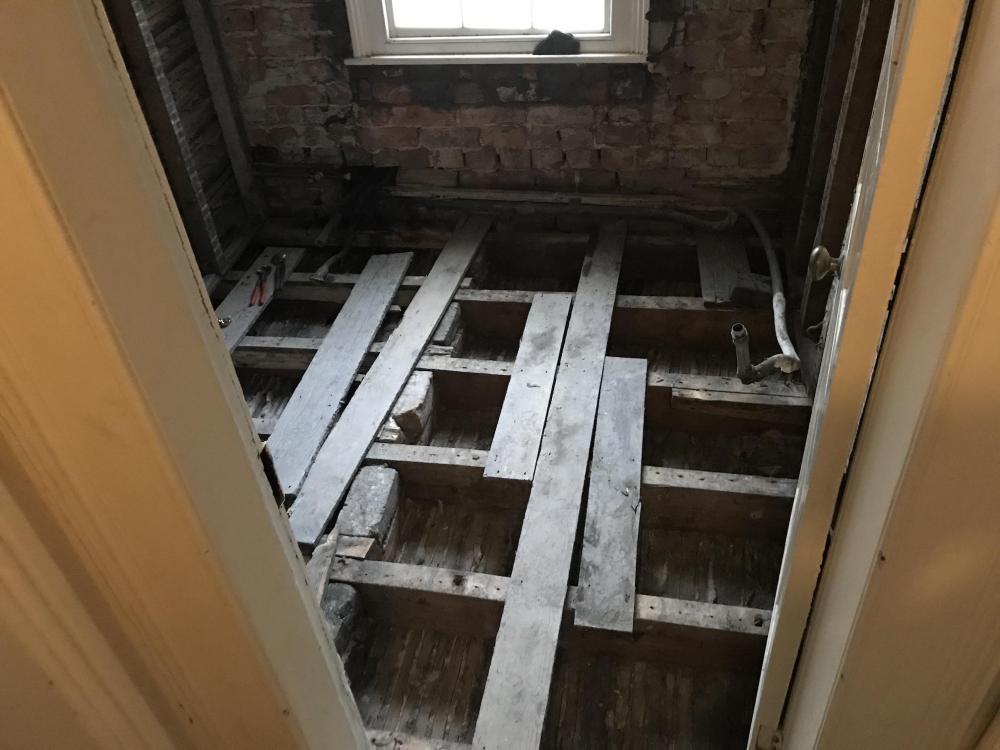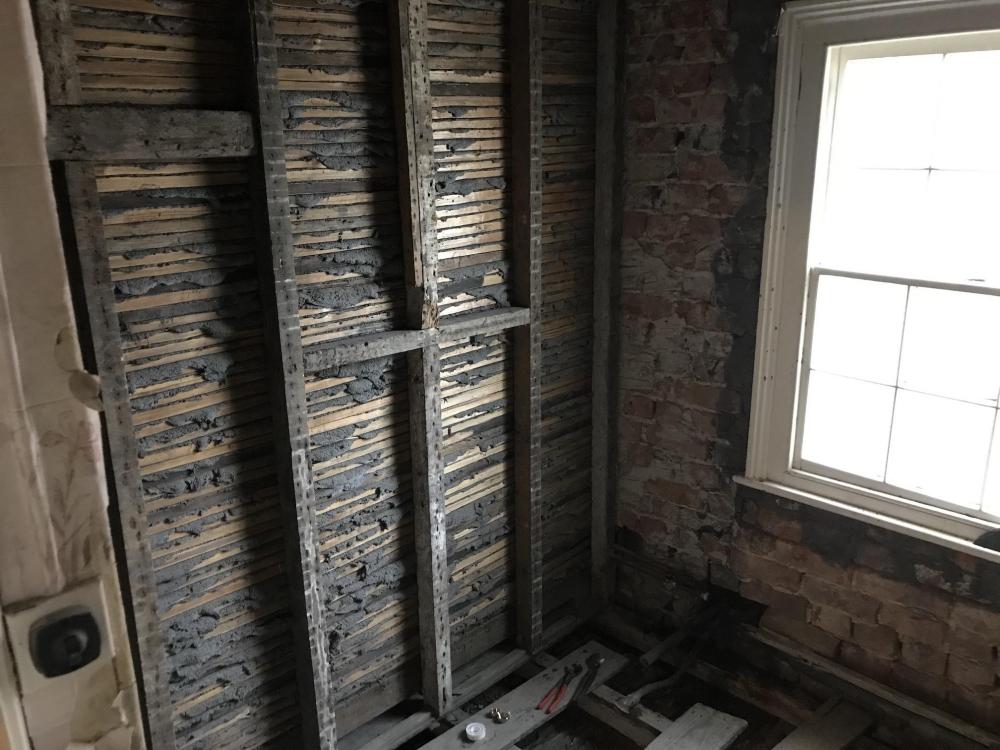Search the Community
Showing results for tags 'wall panels'.
-
Hi all. Am finally underway on a renovation I've been planning and overthinking for a couple years now! We've just finished demolition on the bathroom, which is now this: The room is located on the first (top floor), with lath and plaster walls and ground floor ceilings (under the now removed floorboards), solid brick external walls and timber sash windows. I'm having the window rebuilt and reglazed with double-glazing. We need to re-frame and build the ceiling in this bathroom as the original was about 1" taller than I am with some nasty styrofoam tiles (now gone). I'm wavering on what to put on the external wall and non-wet wall to the right where sink and toilet will be located. The house is 1880-1910 era (with extensions added on variously), with solid brick external walls, 40mm lime plaster on internal walls, and lath+plaster for ceilings and newer walls (like here in the bathroom). There are some damp issues with the house (of course) but wherever I find a problem with dampness or water damage, but I'm growing increasingly skeptical about whether this is actually due to any fundamental issues with the house build - it seems that as soon as I remove wall covering to sort out damp, I find evidence of someone bodging on some anachronistic tech to quickly fix a problem (e.g. a patio outside with bricks blocking the air bricks for the cellar, cheap MDF cabinets in front of brick walls in kitchen, etc.). So, I'm thinking I prioritise draughtproofing and insulation, with good heat-recovery where possible, but also make sure that the building envelope is breatheable as much as possible. Obviously this is a bit tricky in a bathroom. The bathroom is inbetween guest room and MBR, so I'm planning to prioritise sound insulation for internal walls: rockwool sound insulation slabs in the floor and internal walls, and foam tape on the floor joists. Once I have insulation in, I'll put down 18mm plywood, install toilet/sink/bathtub/shower, with a beadboard/tile box around the bathtub and then tile on the floors. The bathtub will be installed on the left side of the room (shown in the photo) against the wall, with shower up overhead. Given the way that my children take baths (e.g. water thrown exuberantly all over the place), I need to put up some seriously hardy boarding on the walls adjacent to the bath. I'm thinking something like schluter kerdiboard (or an equivalent) as I'm hoping for a simple install I can do myself. But what should I put on the back wall? I considered PIR board for a bit of insulation with an air gap and moisture-resistant plasterboard in front, but I'm not sure this will be effective with the space I've got in the joists on that wall (70-90mm) and I'm worried about breathability of that system. So now I'm leaning towards 80mm or so of sheepwool batting, perhaps with woodwool boarding on it, then lime plastered and painted. Has anyone done something like this on a bathroom? Right side walls could just be rockwool acoustic insulation slabs (I gather that sound dampening is much strong than sheepwool with these) and plasterboard in front, but am now wondering if I should just do woodwool board there too? Happy to hear any/all suggestions! Especially if you've tried to do something similar. Floors:
-

Wall Panels for a Bath->Shower swap later
Ferdinand posted a topic in Bathrooms, Ensuites & Wetrooms
Note these are Grant Westfield multipanels not AB Multipanels - AB Building Products are a large distributor in the South West. See this post. I am planning to use the AB Multipanels to line my bath alcove in the Little Brown Bungalow. So far, so good. However, I may want to adapt it to be a shower in say 10 years, and that the price of the panels is quite high at £145 or so for an 8x4 in the standard finishes before you even start getting into trims and fixings. I only need 3 but that will be perhaps 1/3 of the cost of the (reasonably posh) bathroom. Is there any reason why I cannot fit full height uncut panels such that later on the bath can simply be hoicked out and a suitably sized shower installed - eg if a tenant can no longer climb into the bath? Considerations are: Sealing the bath to the panels in a way which is suitable, and can be removed later. Given that both are rigid this should be possible. Installing the shower over the bath now in a way that will not require changes later. Detailing the bottom edge of the panels - probably involving having them a suitable distance off the floor now to allow for a shower tray later. Comments are welcome. Ferdinand- 18 replies
-
- bathroom
- shower panels
-
(and 2 more)
Tagged with:


